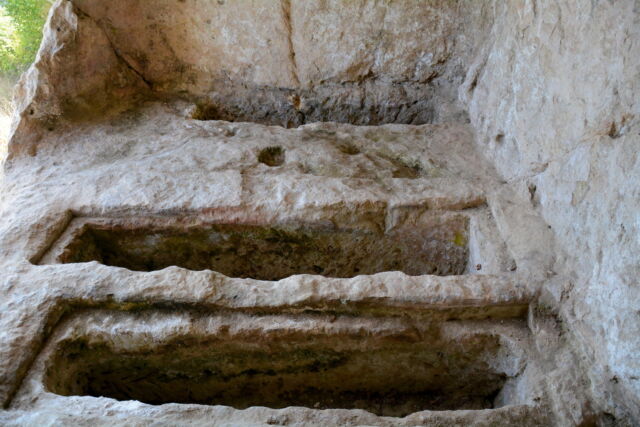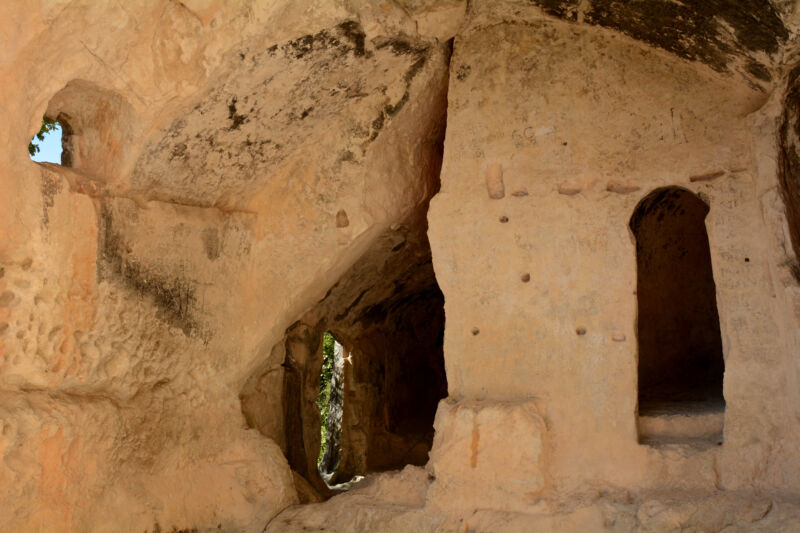Sword blows
First, we found that the inhabitants were overwhelmingly of local Iberian ancestry with very minimal contribution from North Africans—despite their proximity to the northern edge of Al-Andalus.
This aligns with historical records indicating limited genetic influence from North African populations in northern Iberia during the Middle Ages. Nonetheless, some migration did occur, evidenced by several people with higher North African ancestry after the Muslim conquest.
Two of the skeletons dating to the early phase of settlement exhibited signs of violence, which probably resulted from sword blows to the head. The two individuals were genetically closely related. Amazingly, one of them survived an injury that cut through the skull. These skeletons, however, come from a time before the Muslim conquest, so their injuries were not caused by conflicts along the Al-Andalus border.
This period saw elevated levels of inbreeding, with approximately 61 percent of the sample where there was enough genomic data to analyze showing signs of inbreeding (14 out of 23). This suggests that the population at this time practiced endogamy—marrying only within the community.

Together with the evidence for inbreeding, we can see that several of the earliest males are close kin because there are only relatively small variations observed in their Y-chromosome (a package of genetic material passed from father to sons). This suggests that the site could have been populated in the seventh century CE by a small patrilocal (where couples settle in the husband’s home or community) group that may have had experience of warfare.
The early phase of the Las Gobas settlement also revealed several cases of the bacterium Erysipelothrix rhusiopathiae, which causes a skin disease in humans. More interestingly, the bacterium often originates in domestic animals. The bacterium was also present in the settlement’s latter phase, but at a lower frequency.
Smallpox source
The presence of this bacterium, commonly found in pigs, suggests that keeping these livestock animals was an essential part of the community’s lifestyle. Furthermore, one of the people infected with E rhusiopathiae was also carrying Yersinia enterocolitica, a bacterium known to infect humans through bad meat or bad water.
Endogamy remained a strong feature throughout the population’s history, even as the community transitioned from cave dwellings to a more typical rural settlement in the 10th century. During this later phase, we detected DNA from the variola virus, responsible for smallpox, in a 10th-century individual.
Smallpox, with its high mortality rate (30 percent without vaccination), has been suggested by some researchers to have reached Iberia via the Muslim conquest. However, the Las Gobas smallpox strain resembled those found in Scandinavia, Russia, and Germany during the same period. Therefore, it appears as if at least one pandemic route was from the east.
Increased mobility, exemplified by the growing importance of the northern city of Santiago de Compostela for Christian pilgrims in the ninth and 10th centuries, may even have helped spread the virus. In all these ways, Las Gobas stands out as a unique site spanning the turbulent early medieval period in Iberia.
It reveals a community marked by isolation, violence, and devout worship. What started as a cave-dwelling group evolved into a typical rural village that endured its share of disease. As such, the site offers a rare and detailed glimpse into the lives of people whose stories are often eclipsed by history told from the perspective of major urban centers and their elites.
Anders Götherström is Professor in Molecular Archaeology, Department of Archaeology and Classical Studies, Stockholm University, and Ricardo Rodriguez Varela does Research in Molecular Archaeology, Department of Archaeology and Classical Studies, Stockholm University.
This article is republished from The Conversation under a Creative Commons license. Read the original article.












Comments